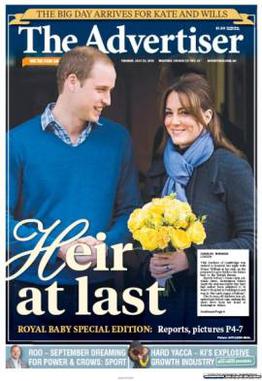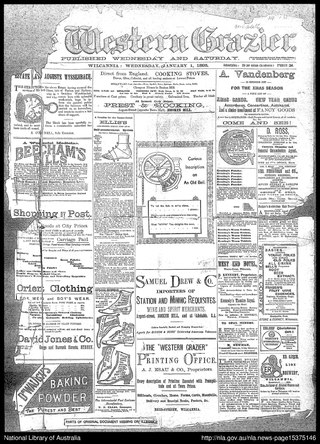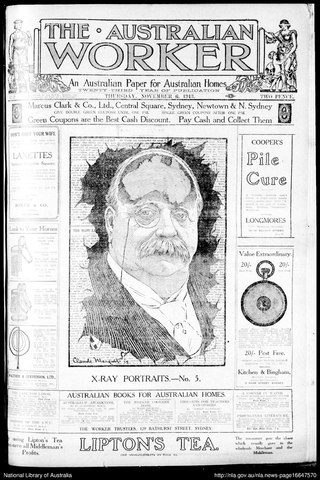Related Research Articles

The Advertiser is a daily tabloid format newspaper based in the city of Adelaide, South Australia. First published as a broadsheet named The South Australian Advertiser on 12 July 1858, it is currently a tabloid printed from Monday to Saturday. The Advertiser came under the ownership of Keith Murdoch in the 1950s, and the full ownership of Rupert Murdoch in 1987. It is a publication of Advertiser Newspapers Pty Ltd (ADV), a subsidiary of News Corp Australia, itself a subsidiary of News Corp. Through much of the 20th century, The Advertiser was Adelaide's morning broadsheet, The News the afternoon tabloid, with The Sunday Mail covering weekend sport, and Messenger Newspapers community news. The head office was relocated from a former premises in King William Street, to a new News Corp office complex, known as Keith Murdoch House at 31 Waymouth Street.
The Register, originally the South Australian Gazette and Colonial Register, and later South Australian Register, was South Australia's first newspaper. It was first published in London in June 1836, moved to Adelaide in 1837, and folded into The Advertiser almost a century later in February 1931.
The Recorder is a newspaper published in Port Pirie, South Australia since 1885. Formed by an amalgamation in 1898, it was also previously known as Port Pirie Recorder and North Western Mail between 1898 and 1918, and as The Recorder from 1919. It was later sold to Rural Press, previously owned by Fairfax Media, but now an Australian media company trading as Australian Community Media.
The Herald was a weekly trade union magazine published in Adelaide, South Australia between 1894 and March 1910; for the first four years titled The Weekly Herald. It was succeeded by The Daily Herald, which ran from 7 March 1910 to 16 June 1924.

The Western Grazier was a newspaper published from 1880 until 1951, covering the central Darling River region of New South Wales. It was published in Wilcannia until 1940, when it moved to Broken Hill.
The Courier is a weekly newspaper published in Mount Barker, South Australia. For much of its existence its full title was The Mount Barker Courier and Onkaparinga and Gumeracha Advertiser, later shortened to The Mount Barker Courier.
Quiz was a weekly newspaper published in Adelaide, South Australia from 1889 to 1910. Between 1890 and 1900 it was known as Quiz and The Lantern.

The Australian Worker was a newspaper produced in Sydney, New South Wales for the Australian Workers' Union. It was published from 1890 to 1950.
The Boomerang was a weekly newspaper published in Brisbane, Queensland, Australia.
The corporate town of Semaphore was a local government area in South Australia. It was created on 20 December 1883, and re-gazetted on 17 January 1884, from areas which had been part of the District Council of Lefevre's Peninsula and District Council of Glanville. The separation of Semaphore would make both its former municipalities unviable, with Lefevre's Peninsula subsequently merging into the District Council of Birkenhead and Glanville with the District Council of Woodville. In 1889, the municipality acquired the Semaphore Institute building for use as the Semaphore Town Hall; the building survives today as the heritage-listed Semaphore Library.
Truth was the name of various weekly newspapers published in Adelaide, South Australia, at times between 1890 and 1964.
The Port Adelaide News was a newspaper published in Port Adelaide, South Australia between 1876 and 1933 with various sub-titles, several breaks in publication and periods of bi-weekly publication.

The Kapunda Herald was a newspaper published in Kapunda, South Australia from 29 October 1864 to 25 January 1951. From 1864 to 1878 the masthead was subtitled "and Northern Intelligencer". It was published weekly, except for the period February 1872 to September 1894 when it appeared bi-weekly. When closed, the newspaper was merged with the Barossa News to become the Barossa and Light Herald.
The Australische Zeitung was a weekly German-language newspaper published in Tanunda, South Australia from 1860 until it ceased publication during World War I in 1916 due to anti-German sentiment. The newspaper also existed in a variety of earlier names or merged publications, reflecting the fluid nature of the newspaper industry in Victorian gold rush era colonial South Australia. The long history of German language Australian newspapers reflects the considerable German-speaking population which settled in South Australia in the nineteenth century.
The Telegraph was a newspaper in Adelaide, South Australia, founded in 1862, and merged with The Express to become The Express and Telegraph, published from 1867 to 1922.
The Weekly Advance was an English-language tabloid newspaper published in Granville, New South Wales, Australia, between 1892 and 1894. The paper principally covered the townships of Granville, Auburn, and Rookwood, with circulation and content extending to Clyde. Flemington, Homebush, Strathfield, Bankstown, Mortlake, Newington, Merrylands, Guildford, Smithfield and Fairfield.

Ignatius Singer was a British writer and speaker on scientific, economic, philological and theological topics during the late 19th and early 20th centuries. He was also an industrial chemist and innovator of textile technology. Born in Hungary, he settled in England and spent some years in Australia and New Zealand.
Thomas Gill CMG ISO was a public servant in South Australia who served as Under-Treasurer from 1894 to 1920.
South Australian Literary Societies' Union (1883–1926) was a peak or advocacy organisation of literary societies in South Australia. It organised competitions between the member societies and established a "Union Parliament" to debate issues of the day.
References
- ↑ "A New Newspaper". The Advertiser . Vol. XXXV, no. 10655. Adelaide. 10 December 1892. p. 5. Retrieved 2 September 2023– via National Library of Australia.
- ↑ "A New Weekly Democratic Paper". South Australian Register . Vol. LIX, no. 14, 927. South Australia. 15 September 1894. p. 6. Retrieved 6 December 2019– via National Library of Australia.
- ↑ The Voice (microform). State Library of South Australia. 1892. Retrieved 13 June 2016.
- ↑ "CricInfo:Players/Ernest Hiscock". ESPN Sports Media Ltd. Retrieved 15 June 2016.
- ↑ "Death of Mr. E. J. Hiscock". South Australian Chronicle . Vol. XXXVII, no. 1, 896. 22 December 1894. p. 8. Retrieved 15 June 2016– via National Library of Australia.
- ↑ "Land Reform Campaign". The Advertiser . Vol. XXXVI, no. 11109. Adelaide. 26 May 1894. p. 6. Retrieved 13 June 2016– via National Library of Australia.